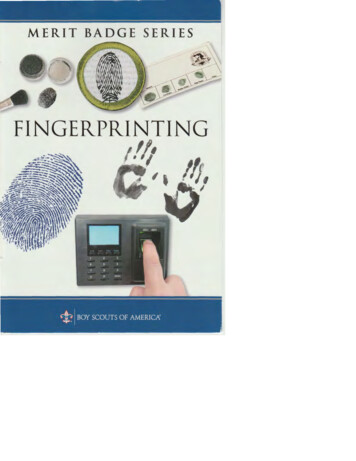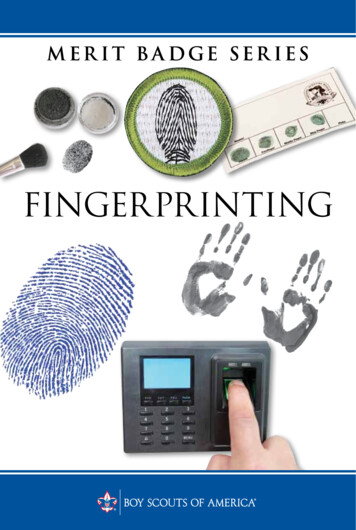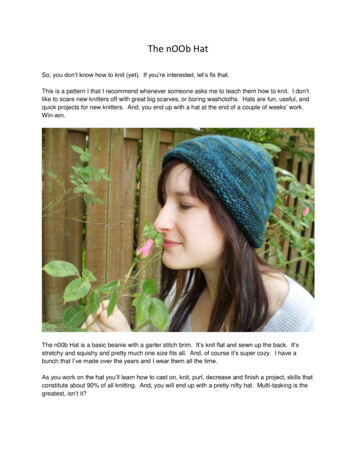
Transcription
MERIT BADGE SERIESFINGERPRINTINGI I
How to Use This PamphletThe secret to successfully earning a meritbadge is for you to use both the pamphlet andthe suggestions of your counselor.Your counselor can be as important to you as acoach is to an athlete. Use all of the resourcesyour counselor can make available to you. Thismay be the best chance you will have to learnabout this particular subject. Make it count.If you or your counselor feels that any informationin this pamphlet is incorrect, please let us know.Please state your source of information.Merit badge pamphlets are reprinted annuallyand requirements updated regularly. Yoursuggestions for improvement are welcome.Who Pays forThis Pamphlet?This merit badge pamphlet is one in a seriesof more than 100 covering all kinds of hobby andcareer subjects. It is made available for you to buyas a service of the national and local councils, BoyScouts of America . The costs of the development,writing , and editing of the merit badge pamphlets arepaid for by the Boy Scouts of America in order to bringyou the best book at a reasonable price.Send comments along with a brief statement about yourself toPilots and Program Development, S272Boy Scouts of America 1325 West Walnut Hill Lane Irving, TX 75038If you prefer, you may send your comments to merit.badge@Scouting.org.
BOY SCOUTS OF AMERICAMERIT BADGE SERIESFINGERPRINTING"Enhancing our youths' competitive edge through merit badges"II\ BOY SCOUTS OF AMERICX
Requirements1. Give a short history of fingerprinting. Tell the differencebetween civil and criminal identification.2. Explain the difference between the automated fingerprintidentification systems (AFIS) now used by law enforcementagencies and the biometric fingerprint systems used tocontrol access to computers and places like buildingsand airports.3. Do the following :a. Name the surfaces of the body where friction orpapillary ridges are found.b. Name the two basic principles supporting thescience of fingerprints and give a brief explanationof each principle.c. Explain what it takes to positively identify a personusing fingerprints.4. Take a clear set of prints using ONE of thefollowing methods.a. Make both rolled and plain impressions. Make these onan 8-by-8-inch fingerprint identification card, availablefrom your local police department or your counselor.b. Using clear adhesive tape, a pencil, and plain paper,record your own fingerprints or those of another person .S. Show your merit badge counselor you can identify the threebasic types of fingerprint patterns and their subcategories.Using your own hand, identify the types of patterns you see.35895ISBN 978-0-8395-3287 -3 2014 Boy Scouts of America2019 Printing SUSTAINABLECertified Ss
ContentsWhat Is a Fingerprint? . . . . . . . . . . . . 5History of Fingerprinting . . . . . . . . . . . . . . . . 9Taking Fingerprints . . . . . . . . . . . . . . . . . . 14Fingerprint Pattern Types . . . . . . . . . 21Latent Prints . . . . . . . . . . . . . . . 25Comparing and Identifying Fingerprints . . . 28Computers and Fingerprints . . . . . . . . . . . 32Fingerprinting Resources . . . . . . . . . . . . . 34Worksheet for Requirement 5 . . 36FINGERPRINTING3.,.
,.
WHAT IS A FINGERPRINT?What Is a Fingerprint?Imagine trying to pick up an ice-cold glass of water using theinside of your arm at the elbow. The smooth skin on the insideof your arm is not designed to grip or create friction the waythe ridged skin on your fingers and palms will grip. Using theinside of your elbow, you are more likely to drop the glassthan if you use the "friction skin" on your fingers and palms.The friction skin on your toes and the soles of your feet servesthe same purpose in giving you traction on slippery surfaces.When you transfer dirt, oil, ink, or other substances fromthe friction ridges of your fingers to a smooth surface, you makefingerprints. Just like an ink stamp, the ridges make contactpatterns on the surface you touch. The shapes and paths of thetops of the friction ridges appear as lines in a fingerprint.FINGERPRINTING5
WHAT IS AFINGERPRINT? Fingerprinting is mostly used by law enforcementagencies in investigating crimes, but fingerprints have otheruses, too. Law enforcement officers use fingerprints, alongwith other materials like matching dental records and DNAsampling, to help identify amnesia victims, missing persons,abducted children, and others.In earning the Fingerprinting merit badge, you willbe learning about and using an important technique inlaw enforcement.The friction skin covering the undersides of yourfingers, palms, soles, and toes resembles theridges of corrugated cardboard. Peel away t hepaper covering from a piece of corrugated cardboard to see the alternating ridges and grooves.1\vo Basic Principles of FingerprintingIn the scientific community at large, the following terminology isconsidered appropriate when speaking of the two basic principlesof fingerprints.Persistence. Fingerprints never change. If you draw a face on anuninflated balloon, then f ill the balloon with air, the features of the facew ill grow with the balloon as you blow it up. Fingerprints are similarin that they remain permanent, only growing larger as a baby growsinto an adult. The small ridges that form on a person's hands and feetbefore birth do not change shape as long as that person lives.Uniqueness. No two fingerprints are alike. The ridges on a person'shands and feet have distinctive, individual details that are never repeatedon the hands or feet of any other person. In more than 100 years ofcomparisons of billions of fingerprints worldwide, no two fingerprintshave been found to have the same features. Even identical twins havedifferent fingerprints.6FINGERPRINTING.,.
WHAT IS A FINGERPRINT?BIFURCATIONENCLOSUREDOTEPIDERMISDUCT OFSWEATGLANDSWEAT GLANDStructure of friction skinPAPILLAEThe skin has three layers: epidermis, dermis, and (notshown in this illustration) subcutaneous tissue. Theepidermis, the outermost layer, is about as thick asa sheet of paper over most of the body. The dermis,the middle layer, is between 15 and 40 times asthick as the epidermis. The surface of the dermis hasmany tiny "pegs;' the papillae, that fit into pits on theunderside of the epidermis. The papillae help fastenthe dermis to the epidermis.Friction ridges are technically known as papillaryridges. Scrapes, cuts, and other minor injuries do notchange the ridge structure or the papillae; the originalridge pattern reappears in any new skin that grows.FINGERPRINTING7.,.
J
H I S T O R Y OF FINGERPRINTINGHistory of FingerprintingPeople have long been aware of the ridge patterns on theirfingers and palms. On a cliff face in Nova Scotia, prehistoric"picture writing" shows a hand with ridge patterns. For centuries the Chinese used thumbprints to seal documents.In 14th-century Persia, official government papers wereimpressed with fingerprints. One government official, aphysician, observed that no two people's fingerprints wereexactly alike.Despite this early awareness that fingerprints were individual and unique, the scientific approach to fingerprinting didnot begin for another three centuries. Here is a summary* ofthe major scientific observations that have led to the modernscience of fingerprinting.Marcello Malpighi-1686During his studies of human skin, Italian anatomist and physician Marcello Malpighi used a microscope to study and describethe ridges, spirals, and loops in fingerprints. While his workwas invaluable in the early use of the microscope, Malpighimade no mention of the value of fingerprints as a tool for identifying individuals.Johannes Evangelista Purkinje-1823Johannes Purkinje, a Czech physiologist, created a classificationsystem for the variety of friction ridge patterns, but his systemfailed to generate much interest in the value of using fingerprints for personal identification.*Much of the information in this section wasadapted from http: //onin.com/ fp.FINGERPRI NTING9.r
HISTORY OF FINGERPRINTING W illiam Herschel-1858The English began using fingerprints in 1858 when Sir WilliamHerschel, a British official in India, had a local businessmanpress his handprint on the back of a contract to discourage theman from not honoring the agreement. The locals believed thatthis personal contact with the document made the contractmore binding than if they had simply signed it. Herschel beganrequiring palm prints- and later, simply the prints of the rightindex and middle fingers-on every contract made withlocal businessmen.Herschel 's experience in India suggests that the first widescale, modern-day use of fingerprints was based on superstition, not science. However, as Herschel's fingerprint collectiongrew, he began to see that the inked impressions could , in fact,prove or disprove identity. He widened his use of fingerprints,convinced that the prints were unique to the individual andpermanent throughout that individual 's life.Henry Faulds-1880During the 1870s, Dr. Henry Faulds, a Scottish physicianworking in Japan, not only recognized the importance of fingerprints for identification, but also created a method of classifying prints. In 1880, the scientific journal Nature publishedFaulds' article about using fingerprints for personal identification and using printer's ink for taking prints. Faulds is creditedwith the first fingerprint identification, of a greasy print left onan alcohol bottle.In 1880, Henry Faulds sent Charles Darwin an explanation of his classification system and a sample of theforms he designed for recording inked impressions.Darwin later passed the materials on to his cousin,Francis Galton.Gilbert Thompson-1882In 1882, geologist Gilbert Thompson became the first Americanto use fingerprints for identification. He printed his own fingerprints on documents to prevent other people from forginghis work.10FINGERPRINTING
H I S T O R Y OF FINGERPRINTINGMarkTwain-1883Author Mark Twain, whose real name was Samuel L. Clemens,brought fingerprinting into the literary world with his 1883 bookLife on the Mississippi, in which a murderer is identified by histhumbprint. Twain's 1894 novel, Pudd 'nhead Wilson, describes adramatic fingerprint identification during a court trial.Francis Galton-1892In the 1880s, Sir Francis Gallon, a British anthropologist andcousin of Charles Darwin, began his studies of fingerprints asa means of identification. In 1892, Calton published his book,Finger Prints, describing the uniqueness and persistence of fingerprints. Calton was able to scientifically prove what Herscheland Faulds already suspected: that fingerprints are permanentand unique to each individual. According to Gallon 's calculations, the odds of two individual fingerprints being the samewere 1 in 64 billion.Juan Vucetich-1892Francis Gaitandefinedcharacteristicsby whichfingerprints canbe identified.These same basiccharacteristicsIn 1891, Juan Vucetich, an Argentine police official, began thefirst fingerprint files based on Calton pattern types. In 1892,Vucetich made the first criminal fingerprint identification. Hewas able to identify a murder suspect from bloody fingerprintsat a crime scene.They are oftenThe Henry System-1901referred to asIn 1901 , fingerprints began to be used for criminal identificationin England and Wales. The classification system was basedon Gallon's observations, as revised by Sir Edward RichardHenry. This began the Henry Classification System, which isstill used today for noncomputerized fingerprint files in Englishspeaking countries.(minutia) arestil l in use today."Galton's details."First Uses in the United States-1902-1903Systematic fingerprinting was introduced in the United Statesin 1902 when the New York Civil Service Commission beganfingerprinting its job applicants. In 1903 , the New York Stateprison system became the first agency in the United States toregularly use fingerprints to identify criminals.Fingerprint Bureaus-1904The penitentiary at Leavenworth, Kansas, and the St. LouisPolice Department established fingerprint bureaus in 1904.The Leavenworth bureau became the first to operate on morethan a local basis. It gradually began to offer a free fingerprintexchange service among a growing list of participating Jawenforcement officers.FINGERPRI NTING11.r
HISTORY OF FINGERPRINTING First American Military Use-1905The U.S. Army adopted a fingerprint system for its soldiers in1905. Two years later the U.S. Navy started using fingerprints,followed by the Marine Corps in 1908.FBI Identification Division-1924In the early years of the 20th century, more and more lawenforcement agencies began using fingerprint systems. In 1924,Congress established the Identification Division of the FederalBureau of Investigation. More than 810,000 fingerprint cardswere collected from other agencies to form the core of the FBIfingerprint files.International Exchange-1932The FBI Identification Division began to exchange fingerprintinformation with foreign countries in 1932 .First PrintTaken From Human Skin-1979Today, the FBIhas more than250 million setsof fingerprintrecords.12In a 1979 Miami, Florida, murder case, a latent (invisible)fingerprint lifted from the victim's hand led to the identificationof the suspect. This was the first case in which a fingerprintwas taken from human skin and successfully used to identifyand convict a criminal.Integrated Automated Fingerprint IdentificationSystem-1999Today, computers perform fast electronic searches for fingerprint matches. In 1999, the FBI implemented its 21st-centuryIntegrated Automated Fingerprint Identification System,
MERIT BADGE SERIES FINGERPRINTING I I . How to Use This Pamphlet The secret to successfully earning a merit badge is for you to use both the pamphlet and the suggestions of your counselor. Your counselor can be as important to you as a coach is to an athlete. Use all of the resources your counselor can make available to you. This may be the best chance you will have to learn about this .









